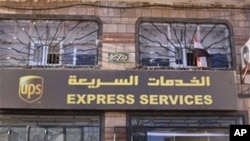Yemeni government authorties say they have arrested a woman on suspicion of being involved in sending two explosive packages from Yemen intended to reach the United States and a wide range of investigations is continued.
Sources in Yemen report that government security forces have been conducting searches across the capital Sana'a throughout the day Saturday. Eyewitnesses report that roadblocks have also been set up across the capital in the investigation over the plot to send booby-trapped packages on cargo planes to the U.S.
There are reports that Yemeni authorities have questioned cargo workers at airports as well as employees of local shipping companies.
The French press agency also says that Yemeni forces have seized 26 suspicious parcels during those searches.
Several unconfirmed reports speak of arrests in connection with the Yemeni investigation. Al Arabiya TV says that a group of suspects with ties to al-Qaida in the Arabian Peninsula leader Qassim al Reimi were captured by the government. However a source at the Yemeni Embassy in Washington denies the reports of arrests.
Al Arabiya TV, speaking with an official in the United Arab Emirates, says that the booby-trapped parcels which originated in Yemen, transited through one other Gulf State before arriving in Dubai, and then being shipped on planes to Great Britain and from where eventually they would go to the U.S.
The TV also says that those arrested in Yemen were involved in the attempt to bomb a Northwest Airlines plane bound for Detroit, last Christmas, as well as the failed attempt to blow up Saudi deputy interior minister Prince Mohammed ben Naif in 2009.
Greg Johnsen, a Yemen scholar at Princeton University, says that the three failed attacks can all be tied to al-Qaida leader Qassim al Reimi, whom he insists is a dangerous individual.
"We do know that Qassim al Reimi is one of the most dangerous, in fact in my opinion THE most dangerous individual within al Qaida. We know that the material used in the two packages that have been uncovered so far was the exact same material that was used in the assassination attempt against (Prince) Mohammed ben Naif, as well at the material that was on the plane to Detroit on Christmas Day (2009)," he said.
Johnsen also points out that attempts to tie U.S.-born Yemeni cleric Anwar al Awlaki to the plot by Western media belies the fact that Awlaki is not really a very senior member of the organization. "Anwar al Awlaki is a fairly mid-level player within al-Qaida, so the media attention, particularly in the West, that focuses on him is much more a result of the fact that he carries U.S. citizenship and speaks fluent English… He certainly doesn't hold a rank very high in the organization," he said.
Johnsen notes that al-Qaida uses al Awlaki for notoriety and to take advantage of "free publicity," but argues that other top leaders such as Qassim al Reimi, Nasser al Ruheishi and Ali al Shehri "are much more dangerous."
Yemen Seizes Dozens of Suspicious Parcels in Bombing Plot














